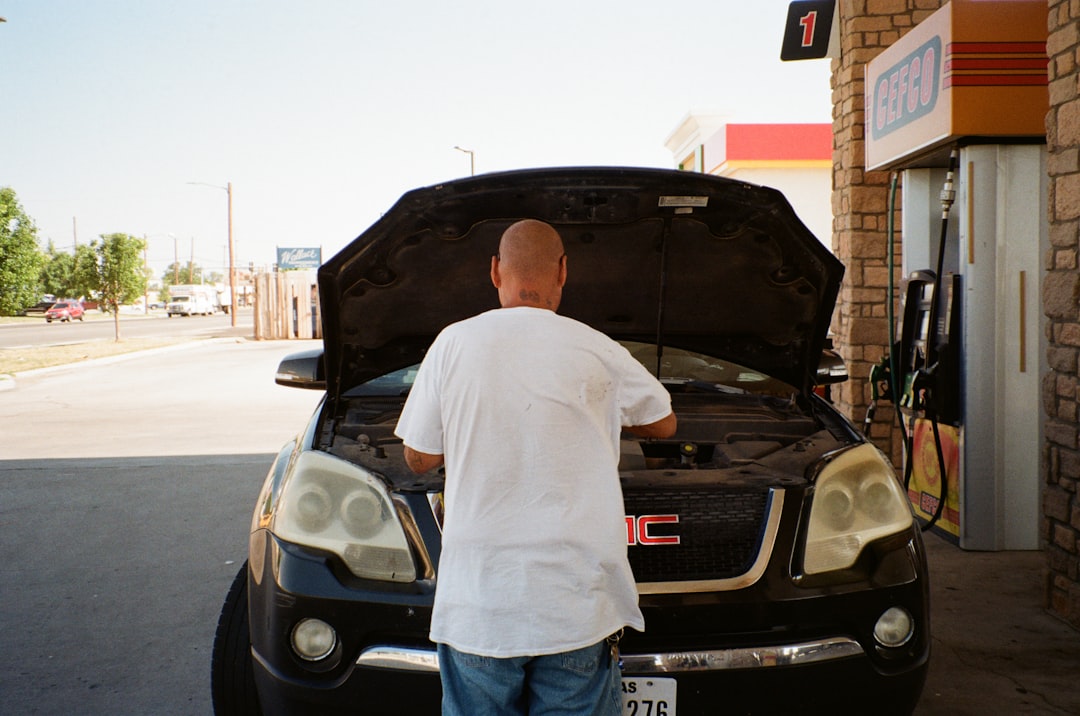

Engage prospects with a scan and streamline customer engagement with FREE QR code marketing tools by Sona – no strings attached!
Create a Free QR CodeFree consultation

No commitment

Engage prospects with a scan and streamline customer engagement with FREE QR code marketing tools by Sona – no strings attached!
Create a Free QR CodeFree consultation

No commitment
QR codes have evolved from curiosity to a powerful bridge connecting offline engagement with online action, especially for car service providers. They offer a simple yet effective method to drive leads, streamline service appointments, and create measurable touchpoints throughout the customer journey. Auto repair shops, car maintenance services, vehicle warranty providers, and automotive service centers often struggle to capture high-value interactions, with traditional methods leaving gaps where prospects go untracked. Sona is an AI-powered marketing platform for attribution and activation; see Sona’s offline attribution guide.
Scheduling repairs, accessing car service reviews, or managing warranty details frequently involves outdated analog touchpoints like printed brochures, manual sign-up forms, and business cards. These slow the customer journey and increase the chance of losing valuable leads. Prospects may show intent without filling a form, leaving businesses with no way to follow up. QR codes empower providers to move past these hurdles, enabling customers to instantly access schedules, book appointments, or check reviews via a Google reviews QR for a seamless offline-to-online experience.
This guide shows car service providers how to leverage QR code solutions to capture high-intent interactions, deliver smooth customer experiences, and optimize marketing ROI. You will find strategies to address pain points such as limited visibility into foot traffic, follow-up on prospect interest, and proof of which channels bring in business. Gain practical tips, operational tactics, and insights to transform your automotive services using QR codes, from first scan to measurable revenue. For sector-specific tactics, explore Sona QR’s automotive guide.

QR codes bridge the gap between physical touchpoints and digital outcomes, making it easier to achieve real business goals like lead generation, repeat bookings, and enhanced customer experience. Yet, many providers lose high-value prospects simply because these interactions are not tracked or actionable.
Here is how to do it effectively:
Analog processes like printed brochures, manual sign-up sheets, and phone-only scheduling create drop-off between interest and action. Replacing these with QR-driven flows streamlines every step. Example: Swap paper brochures for a QR that opens a mobile-friendly tire comparison guide with a book-now button. Replace manual loyalty sign-ups with a QR that pre-fills a form using device autofill. These incremental improvements reduce friction and convert on-the-spot interest into trackable outcomes.

Car service providers often find that prospects research or visit without signaling their intent, leaving staff unaware at crucial moments. Lack of insight into anonymous walk-ins and passive interest leads to wasted marketing spend and lost opportunities. QR codes solve those gaps by turning passive attention into measurable action. See QR codes in marketing for a broader overview.
Example: Service centers add QR codes to dashboard cards that say “Need a brake check in 90 days? Scan to pre-book.” Warranty providers embed QR codes on paperwork for instant renewal or support access. These small changes create clear paths from offline interest to online conversion. See ideas for QR codes for cars.

Capturing high-intent actions in real time requires choosing the right QR code format for the moment. Automotive service businesses benefit most when the format maps precisely to the action you want.
Dynamic codes are best for campaigns that require tracking, editing destinations, or testing messages. Static codes are suitable for permanent resources like a warranty explainer or a fixed PDF. Platforms such as Sona QR support both, letting you centralize management, apply UTM templates, and compare performance across formats.

Many opportunities are lost because businesses cannot track or retarget anonymous visitors. Strategic QR code deployment creates a participatory, data-rich environment that brings people from interest to action across your facility and in your local market.
Matching code placement to the customer journey makes it easy for high-interest, anonymous visitors to opt in. Over time, this creates a consistent flow of trackable signals you can nurture with personalized messaging and offers.

Despite strong interest, many prospects never submit a form or book onsite, which makes their intent invisible. QR codes transform that dynamic by capturing micro-moments and linking them to outcomes.
Each use case turns previously untracked moments into measurable steps. Over time, these scans create a dataset that informs better staffing, smarter promotions, and higher-lifetime-value relationships.
Visibility into anonymous engagement remains a common problem in automotive services. Each QR scan provides an intent signal that you can track and nurture across email, SMS, and ads—see Sona’s playbook intent-driven retargeting. Deploy unique QR codes across your environment so that every scan builds a segment you can activate.
For car service providers, useful audience distinctions include owners versus prospects, warranty customers versus out-of-warranty, first-time visitors versus repeat clients, and interest clusters such as brakes, tires, or diagnostics. When you tailor messaging by segment, you reduce wasted impressions and increase conversion velocity.
QR codes are more than convenient links. They act as connectors across offline and digital campaigns, enabling real-time engagement and richer data collection at every step of your marketing mix.
With a centralized platform like Sona QR, you can manage all codes, monitor performance, and sync scan data with your CRM and ad platforms. This creates a connected funnel in which offline engagement feeds your digital engine and produces measurable outcomes.
It can be tough to tie offline engagement to revenue. A methodical QR campaign process gives you the structure to capture intent and iterate quickly across placements, offers, and formats.
Start with a specific, high-value business problem. For car service providers, common goals include reducing missed repeat appointments, increasing review volume, improving approval rates for big-ticket repairs, and capturing more warranty renewals. By choosing a single use case, you can design a focused landing experience and a clear call to action.
Align the QR code with a measurable outcome. For example, “increase oil change rebookings by 20 percent” or “collect 50 new reviews this month.” Clear targets inform your creative and placement decisions. For a community car care clinic, the use case might be “event RSVP and lead capture” using a QR code on flyers and social posts that point to a short sign-up form with reminders.
Select static or dynamic based on your needs. Static codes are fine for unchanging destinations like a permanent warranty overview or a shop hours page. Dynamic codes allow editing the destination after printing, gathering analytics, adding UTM parameters, and routing people to different pages based on location or device.
Match the format to the action. Use a form code for feedback collection, a web-link code for appointment booking, a vCard to save a service advisor’s contact, or an app-download code for loyalty program enrollment. If you plan to measure and optimize over time, dynamic codes managed in a platform like Sona QR are the smarter choice.
Design for visibility and intent. Add your logo and brand colors around the code, maintain high contrast, and include a descriptive call to action right below the code, such as “Scan to Book Now” or “Scan for a Free Brake Inspection.” Place the code where the phone can easily approach, not too high or at awkward angles.
Test in real conditions. Check scannability on different phones, from different distances, and under various lighting. Print sizes should be appropriate: a small desk sign may use a 1.5 to 2 inch code, while wall signage needs larger. Ensure the landing page is mobile-first, loads quickly, and matches the promise in your CTA.
Roll out codes where your audience already is. For auto service, the highest-impact placements include check-in counters, invoices and receipts, windshield stickers, direct mailers, waiting area posters, email signatures, and community event materials. Each placement can use a unique code to capture context and performance.
Match placement to behavior. For example, put “Scan to review your experience” at pick-up when satisfaction peaks. Use “Scan to schedule your next oil change” on the oil change sticker. Use “Scan for financing” near the cashier for big-ticket approvals. Map each code to a buyer journey stage to guide people smoothly toward conversion.
Instrument analytics from day one. Use Sona QR or a similar tool to track scans by time, location, device, and campaign. Add UTM parameters so your analytics platform and CRM attribute booking, form fills, and revenue to the correct source. For CRM alignment, see Sona + HubSpot.
Iterate based on what you learn. A/B test landing pages, change CTAs, experiment with code size and placement, and refresh offers seasonally. Look for leading indicators like scan-to-visit rate, scan-to-booking conversion, and percentage of new versus returning customers. Feed insights back into your print and in-store strategies to compound gains over time.
Measuring ROI from offline campaigns is one of the biggest obstacles for service centers. Modern QR tools bridge this gap by capturing first-party engagement data and tying it to downstream outcomes like bookings, approvals, and revenue.
Sona QR captures the scan event and context, while Sona.com connects anonymous scans to known buyers through identity resolution and multi-touch attribution. Together, they unify offline and online touchpoints into a single view of buying stages, helping you report impact with confidence and optimize spend where it matters most.
Missed leads are often due to poor QR segmentation, weak promotion, or inconsistent follow-up. Improve outcomes with a few proven practices tailored to automotive environments.
These steps strengthen your pipeline across acquisition, conversion, and retention. Over time, the data you gather will spotlight your most profitable surfaces, messages, and moments.
Traditional barcodes encode a limited set of static characters, which makes them useful for inventory but ineffective for interactive customer experiences. They cannot route to booking flows, update destinations, or capture rich analytics across contexts.
QR codes offer dynamic, scannable entry points that can trigger actions like scheduling, payment, or warranty lookup. You can update a QR’s destination without reprinting, add parameters for analytics, and segment by placement to understand behavior. In practice, this means a single printed asset can evolve with your promotions and allow precise attribution.
For car service providers, the difference is material. An oil filter box with a standard barcode helps with stocking; a counter sign with a QR code fills your calendar. QR codes add flexibility, measurability, and agility, which translates into more conversions and better customer experiences.
QR code adoption is accelerating as providers address pipeline leaks like missed follow-ups and untracked interest. The next wave will integrate QR with connected car data and location-aware experiences, creating smarter prompts and proactive service journeys.
Expect tighter integrations with IoT devices and telematics. Vehicles that surface maintenance alerts could pair with QR codes on service reminders or in-app notifications, routing customers to pre-filled booking forms showing recommended services, estimated costs, and loaner availability. EV charging stations already use QR codes for payment and loyalty sign-in, creating natural bridges to services like tire rotations and battery health checks.
Warranty renewals are shifting from analog paperwork to scan-driven digital flows. A QR on a glovebox card can authenticate coverage, present renewal pricing, and offer live chat support in seconds. For fleets, QR codes on driver cards or vehicle stickers can connect to maintenance portals that capture mileage and prompt scheduled service, improving compliance at scale.
Security and trust are critical. As QR usage grows, so does the risk of spoofed codes or malicious redirects. Mitigate risk with a few practical measures:
Industry leaders are measuring campaign ROI year over year and refining their strategies using robust analytics. With this approach, automotive service businesses can retain more customers, upsell more effectively, and continuously re-engage new and returning visitors, closing the historic gap left by untracked walk-ins.
QR codes are transforming how car service providers engage with customers, tackling pain points like lost prospects, limited insight into offline interactions, and the struggle to connect spend to revenue. With strategic placement across service centers, print assets, and digital campaigns, QR codes create instant pathways for booking, feedback, and vehicle management without old bottlenecks.
By rethinking every customer interaction with QR in mind, providers capture and nurture high-intent signals, from a walk-in who did not book to a warranty question or a follow-up opportunity. Actionable scan data ensures each moment can be measured, optimized, and attributed to growth, turning every engagement into revenue.
Providers ready to modernize will find QR-driven campaigns and analytics deliver the visibility and agility needed to compete. Start piloting in one or two high-traffic placements, measure scan-to-book conversions, and expand what works. With Sona QR to power your codes and Sona.com to connect scans to pipeline and revenue, you can turn every customer moment into measurable business growth.
Start creating QR codes for free.
QR codes have revolutionized the car service provider industry by transforming traditional customer interactions into seamless, measurable conversion opportunities. Whether it’s streamlining appointment bookings, offering exclusive service promotions, or providing instant access to vehicle maintenance history, QR codes enhance customer acquisition and elevate the overall service experience. Imagine knowing exactly which marketing channels bring in new clients and being able to optimize your efforts instantly.
With Sona QR, you can create dynamic, trackable QR codes in moments, update campaigns on the fly without costly reprints, and directly link every scan to revenue growth. This powerful tool helps you connect offline customer touchpoints to actionable insights, ensuring no lead is missed and every engagement drives your business forward. Start for free with Sona QR today and turn every scan into a loyal customer and increased service bookings.
You can find reliable car service providers by using QR codes placed on invoices, brochures, and stickers that link to verified booking pages and customer reviews, enabling seamless access to trusted providers.
Car service providers use QR codes to offer appointment scheduling, vehicle history access, warranty information, customer feedback collection, financing and payment options, and parts and accessory upsells.
You can schedule an appointment by scanning QR codes found on flyers, receipts, oil change stickers, or service bay signage, which link directly to mobile-friendly booking pages with pre-filled service options.
While the article does not specify exact costs, QR codes provide access to service menus and pricing details, allowing customers to view and compare typical costs before booking.
QR codes streamline the customer journey by replacing paper forms and manual scheduling with instant access to booking, reviews, payment, and service information on mobile devices, reducing friction and lost leads.
QR codes are commonly placed at service desks, waiting areas, vehicle stickers, direct mail flyers, invoices, lobby signage, and cashier desks to capture high-intent customer actions.
Car service providers use web link QR codes for scheduling and info, vCards for contact sharing, forms for data collection, app download codes for loyalty programs, and Wi-Fi access codes for waiting area engagement.
They use dynamic QR codes with UTM parameters integrated into analytics and CRM systems to track scan volume, conversion rates, customer behavior, and attribute revenue to specific campaigns and placements.
Providers should use large, high-contrast codes with clear calls to action placed in visible, accessible locations like checkout counters, waiting rooms, and vehicle tags, while testing scannability on multiple devices.
Use branded frames and trusted domains, educate staff and customers to scan only official codes, regularly audit and rotate codes, and ensure secure HTTPS destinations to mitigate spoofing and malicious redirects.
Each QR scan provides intent signals that can be segmented by funnel stage, behavior, and location, enabling targeted follow-up through CRM and ad platforms to increase conversion and retention.
QR codes offer dynamic, updateable links that enable interactive customer actions like booking, payments, and feedback, along with rich analytics and multi-touch attribution, unlike static barcodes used mainly for inventory.
Providers can add QR codes to print collateral, social media, direct mail, digital signage, and events, creating measurable touchpoints that drive real-time engagement and connect offline interest to online actions.
Use unique codes by placement, add UTM parameters, trigger automated follow-ups, train staff to encourage scanning, and creatively place codes on items like oil change stickers and keychain tags.
They capture detailed scan data including time, location, and device, integrate scan events with CRM systems, monitor campaign performance in real-time, and use multi-touch attribution models to link scans to bookings and sales.
Future trends include integration with connected car data and IoT devices for proactive maintenance prompts, digital warranty renewals via QR codes, fleet maintenance tracking, and expanded use at EV charging stations.
Use Sona QR's trackable codes to improve customer acquisition and engagement today.
Create Your FREE Trackable QR Code in SecondsJoin results-focused teams combining Sona Platform automation with advanced Google Ads strategies to scale lead generation

Connect your existing CRM

Free Account Enrichment

No setup fees
No commitment required

Free consultation

Get a custom Google Ads roadmap for your business






Launch campaigns that generate qualified leads in 30 days or less.
